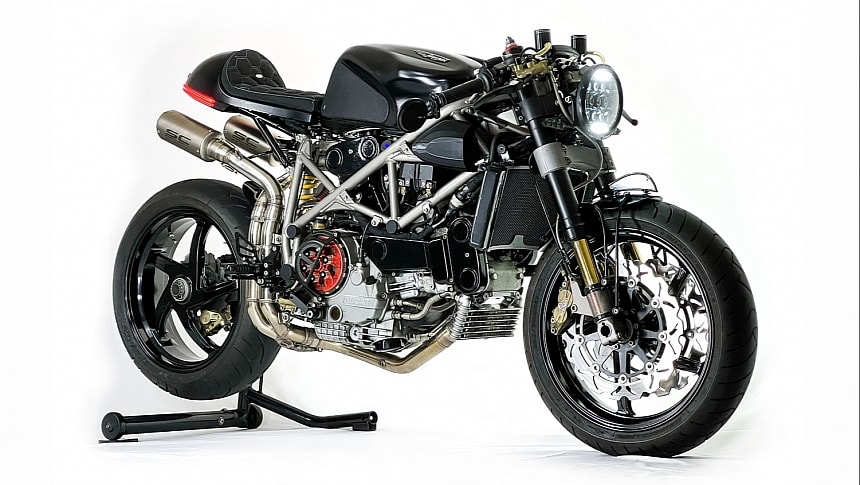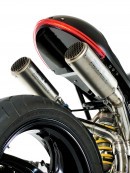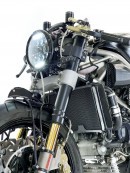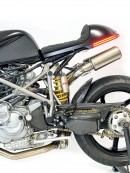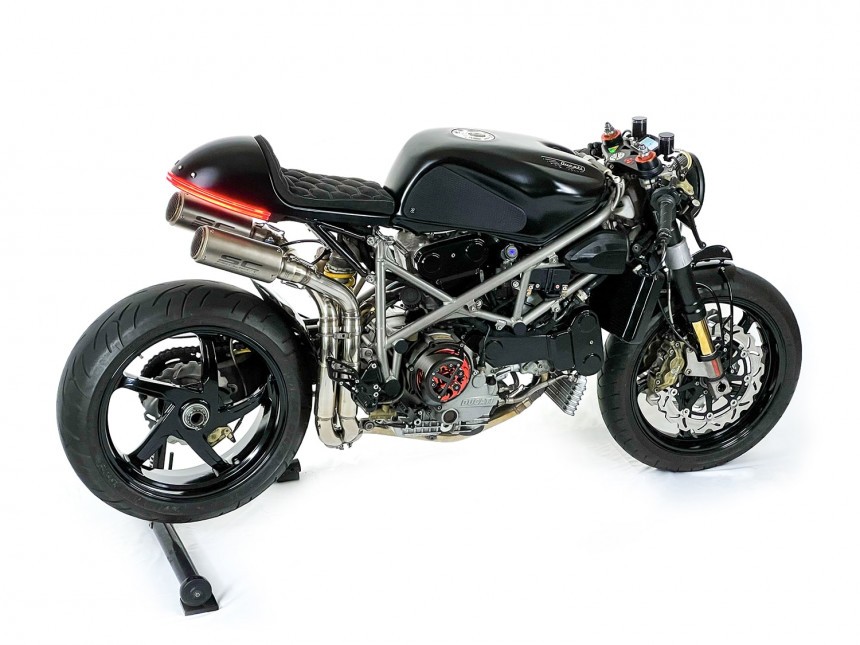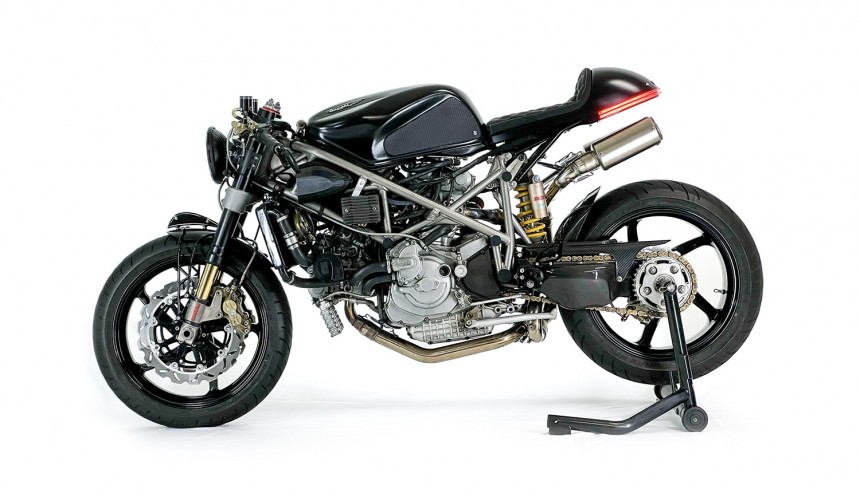Given the model’s iconic status, most people would deem the act of customizing a Ducati 996 as unsavory, but there is perhaps one exception to this rule. If the bike in question had previously been ruined in some way, either by a crash or a failed modding endeavor, then the custom way is fair game. Case in point, the 996 cafe racer pictured here was rescued by a talented amateur builder named Jaron Hall.
As his day job, the guy works in the marketing department of a tech start-up from Salt Lake City, Utah, but you’ll often find him indulging in custom projects afterhours. The quality of Jaron’s builds is always top-notch despite the time-related constraints of his daily routine, and that’s made perfectly clear by this caffeinated Ducati. First, let’s talk about what led Jaron to modify a cult classic like the 996.
You see, the project’s donor was far from the pristine specimens cherished by collectors, as it had been utterly disfigured under previous ownership. Someone thought it would be a good idea to have the Duc turned into a scrambler, but their execution was pretty disastrous to say the least. It was therefore a blessing for this motorcycle to end up in Jaron’s possession, because it needed a new chance at life and he was the perfect man for the job.
To get the ball rolling, he took the bike apart and proceeded to delete all the cheap junk installed by the past owner. Next up, Jaron put his metal fabrication skills to work, constructing a neat tubular subframe from scratch and bolting it to the main trellis skeleton via the original mounting points. Atop the new rear framework lies a cafe racer tail unit made of fiberglass.
In turn, the tail is topped with a stunning custom saddle, upholstered in black Alcantara and stitched up in a honeycomb pattern with white thread. This new seat was put together in-house by Jaron’s capable hands, but so was the mesmerizing taillight placed further back. Our protagonist brought it into existence with plexiglass and an LED lighting strip, as well as plenty of cosmetic influence from the Aston Martin Vulcan.
The tail’s underside is encased in metal plates to keep things looking nice and clean – a simple, yet undeniably effective setup. Making our way northward, we still find the factory 996 fuel tank placed center-stage, but it is the only piece of stock bodywork left in play here. The bike’s front end is home to a small fender, held in place via custom brackets that mimic the look of the trellis frame.
What’s more, the mudguard is topped with a vintage-style ornament to enhance the Duc’s retro-like charm. One may find a pair of beefy air vents further back, attached to the frame tubing on each side of the fuel tank and sporting hexagonal grilles that match the stitch pattern of the seat. Front-end lighting comes from a bright LED headlamp of aftermarket origin.
It’s held in place via custom brackets and flanked by some very interesting turn signals, each comprising three individual lighting units mounted besides one another. Up in the creature’s cockpit, we come across a replacement top clamp with integrated warning lights, as well as aftermarket clip-ons featuring premium master cylinders and underslung bar-end mirrors.
A Shorai lithium-ion battery is hidden out of view in a tailor-made box, and all the electronics are hooked up to a fresh wiring harness. In terms of powertrain mods, Jaron fitted an aftermarket radiator for improved cooling and a stainless-steel exhaust system. The latter ends in twin SC-Project silencers right below the subframe tubing, in similar fashion to the factory setup.
There is also an open clutch cover, exposing a red pressure plate and letting the iconic dry clutch sound be heard more clearly. Some carbon fiber goodness is present on this build, as well, in the form of a sharp rear wheel hugger, a new chain guard, and a replacement front sprocket cover. As the 996 carries high-grade suspension hardware from Showa, there was no need to upgrade it in any way.
Jaron also left the stock Brembo brake calipers as they were, but he did replace the discs with wave-style aftermarket substitutes at both ends. Billet aluminum rearsets round out the ergonomic package on this machine, both equipped with additional LED taillights. The finishing touches consist of classy Ducati tank badges and a grippy set of Bridgestone Battlax tires.
The project’s author kept things simple when it came to the paint job, wrapping the bodywork, Marchesini wheels, and upper forks in a layer of satin-black. On the other hand, the main frame bears a stylish silver finish for contrast, and there are various pinches of red and gold here and there. All things considered, Jaron Hall really managed to make a silk purse out of a sow’s ear with this conversion.
You see, the project’s donor was far from the pristine specimens cherished by collectors, as it had been utterly disfigured under previous ownership. Someone thought it would be a good idea to have the Duc turned into a scrambler, but their execution was pretty disastrous to say the least. It was therefore a blessing for this motorcycle to end up in Jaron’s possession, because it needed a new chance at life and he was the perfect man for the job.
To get the ball rolling, he took the bike apart and proceeded to delete all the cheap junk installed by the past owner. Next up, Jaron put his metal fabrication skills to work, constructing a neat tubular subframe from scratch and bolting it to the main trellis skeleton via the original mounting points. Atop the new rear framework lies a cafe racer tail unit made of fiberglass.
In turn, the tail is topped with a stunning custom saddle, upholstered in black Alcantara and stitched up in a honeycomb pattern with white thread. This new seat was put together in-house by Jaron’s capable hands, but so was the mesmerizing taillight placed further back. Our protagonist brought it into existence with plexiglass and an LED lighting strip, as well as plenty of cosmetic influence from the Aston Martin Vulcan.
What’s more, the mudguard is topped with a vintage-style ornament to enhance the Duc’s retro-like charm. One may find a pair of beefy air vents further back, attached to the frame tubing on each side of the fuel tank and sporting hexagonal grilles that match the stitch pattern of the seat. Front-end lighting comes from a bright LED headlamp of aftermarket origin.
It’s held in place via custom brackets and flanked by some very interesting turn signals, each comprising three individual lighting units mounted besides one another. Up in the creature’s cockpit, we come across a replacement top clamp with integrated warning lights, as well as aftermarket clip-ons featuring premium master cylinders and underslung bar-end mirrors.
There is also an open clutch cover, exposing a red pressure plate and letting the iconic dry clutch sound be heard more clearly. Some carbon fiber goodness is present on this build, as well, in the form of a sharp rear wheel hugger, a new chain guard, and a replacement front sprocket cover. As the 996 carries high-grade suspension hardware from Showa, there was no need to upgrade it in any way.
Jaron also left the stock Brembo brake calipers as they were, but he did replace the discs with wave-style aftermarket substitutes at both ends. Billet aluminum rearsets round out the ergonomic package on this machine, both equipped with additional LED taillights. The finishing touches consist of classy Ducati tank badges and a grippy set of Bridgestone Battlax tires.
The project’s author kept things simple when it came to the paint job, wrapping the bodywork, Marchesini wheels, and upper forks in a layer of satin-black. On the other hand, the main frame bears a stylish silver finish for contrast, and there are various pinches of red and gold here and there. All things considered, Jaron Hall really managed to make a silk purse out of a sow’s ear with this conversion.
